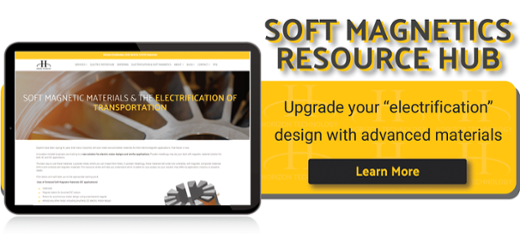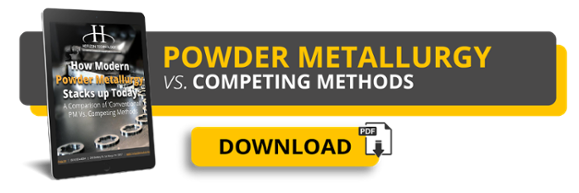Soft magnetic composite is maybe the best-kept secret in AC electric motor design. We’ve exhaustively covered the cost and performance benefits this advanced powder metallurgy material can offer vs., say, a stamped electric steel lamination.
That doesn’t mean soft magnetic composite (SMC) material should be used for making all motor components (or powder metal components, for that matter). Sometimes it just doesn't make sense for your project's needs. However, what people think they know about SMC and powder metallurgy (PM) often doesn't line up with today's reality.
Does your motor design project fall under one of the categories below? If so, it's time to re-evaluate which soft magnetic material is ideal for you.
(Related post: When SHOULD You Use SMCs?)
When to Question SMC as Your Soft Magnetic Material
Soft magnetic composite is a powder consisting of electrically insulating particles. Their goal is to improve the magnetic performance of many motors and similar AC electromagnetic designs.
If the motor (or similar product) you're manufacturing falls under one of these categories, ask your supplier if there's a better material fit:
- 50-60 Hz AC induction motors
- Other low-frequency products where design creativity isn't important
- High-strength
- Big motors (sometimes)
- Other DC electric motors
1. Standard (50-60 Hz) AC Induction Motor Designs
The inherent performance of soft magnetic composites at low frequencies like 50-60 Hz is not adequate for electric induction motor designs (like in your bathroom exhaust fan).
There’s a fundamental reason.
These motors don't have any windings in the rotor. They’re induced through their permeability aspect (the applied magnetic field from an electric motor stator's material).
Because the permeability of SMCs is generally lower than that of laminations, it’s not exactly the most common electric motor material used for induction styles. You won’t get the starting torque and performance you’re hoping for. You'll also see lamination steel used in transformer cores because of the need for high permeability.
Once you get to ~60 Hz and above, though? The sky's the limit with SMCs when it comes to performance at high frequencies -- up to 10,000 and beyond.
2. Most 50-60 Hz Products Where You Have No Desire to Design
You can absolutely overcome the limitations in case #1, if the benefits of SMC mean enough to your application. Just know that you have to be willing to rethink your design.
The point is to optimize the motor to fit soft magnetic composites’ unique properties. If you don’t want to redesign, then it's a waste of your time and your powder metallurgy manufacturer’s time to bother with SMCs.
Cost efficiency is another factor in choosing materials for 50-60 Hz projects. Large-scale manufacturers making motors have stamping presses that run tremendously fast. There are certain segments of the market -- commodity products -- where it makes no financial sense to choose SMCs.
3. When Strength Is Critical
Unfortunately, powder metal parts made via SMC are a bit brittle compared with laminations.
Stress during rotation can possibly exceed the strength of a component made from soft magnetic composite. So something that rotates at high speed -- like a rotor in an AC motor design -- isn’t a good fit with soft magnetic composite.
You can get by using SMCs as your electric motor rotor material in small designs, but as you get into bigger ones, strength requirements are high at the components' edges. You’d need some careful calculation and design to avoid ending up with broken parts..
4. Big Motors (Sometimes)
A gargantuan motor would require many soft magnetic composite parts to be both stacked and assembled. If so, there’s potential for needing tolerances outside of your current component plans.
Does your motor component need to go under a compaction press? A motor that’s 2’ or even just 18” in diameter won’t fit in a powder metal press. You have to make the components small and stack them together.
While the electric motor assembly process is typically far smoother with SMC parts than with, say, lamination stacks, huge motors can be problematic. A standard large-motor design doesn’t need that hassle -- unless it's such a unique shape that SMC's the only way to achieve it while maintaining performance.
However, if you do want something special ...
Through segmentation, SMC parts can actually facilitate easier winding, reducing core losses even further. Not to mention SMC products don't degrade in magnetic performance as assembly size increases, like lamination stacks do.
If you do want to consider running a large motor part through the powder metallurgy process, just remember these pointers:
- In general, SMC parts should have a minimum length of 0.06", or 1.725 mm, in the pressing direction.
- It can be difficult to form parts more than 2" long in the pressing direction.
- The rules of powder metallurgy design are made to be broken. If your design falls just outside these lines, find a powder metallurgy company willing to consider size limits on a part-to-part basis.
5. Other DC Electric Motor Designs
Comparing the properties of soft magnetic materials isn't always apples-to-apples.
DC electric motor materials need to promote two traits above all others: speed control and output range. Since AC materials are optimized for power output and efficiency, they fall a little short in those first two traits.
Fortunately, a cousin of SMC -- sintered soft magnetic material -- also exists under the umbrella of advanced powder metal materials. This material group maintains the shape-making capability and much of the magnetic performance of SMCs, but adds impressive strength and ductility. Today you can even heat treat these materials at up to 2500 °F for further strength performance (if your supplier has the capability).
More Questions About Your Project?
Hopefully you have a better idea of the ideal material process for your application. If you haven’t checked off any boxes on this list, check out this article on ideal uses for soft magnetic composites. Even if you did check off one box, consult with a powder metallurgy services provider before you stick with the status quo -- remember, rules are made to be broken with SMC!
You’ll be surprised what you can create with the flexibility and performance of this material.
If you have further questions about how powder metal materials might work -- or not work -- with your project, click below.
(Editor's note: This article was originally published in November 2018 and was recently updated.)




